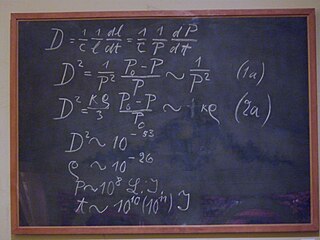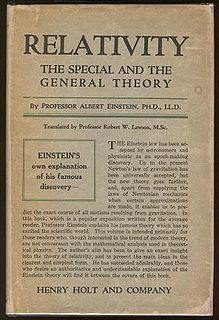 W
WAlbert Einstein (1879–1955) was a renowned theoretical physicist of the 20th century, best known for his theories of special relativity and general relativity. He also made important contributions to statistical mechanics, especially his treatment of Brownian motion, his resolution of the paradox of specific heats, and his connection of fluctuations and dissipation. Despite his reservations about its interpretation, Einstein also made seminal contributions to quantum mechanics and, indirectly, quantum field theory, primarily through his theoretical studies of the photon.
 W
WAlbert Einstein Archives refers to an archive on the Givat Ram campus of the Hebrew University of Jerusalem in Jerusalem, housing the personal papers of 20th century physicist Albert Einstein.
 W
WThe Annus mirabilis papers are the four papers that Albert Einstein published in Annalen der Physik, a scientific journal, in 1905. These four papers were major contributions to the foundation of modern physics. They revolutionized science's understanding of the fundamental concepts of space, time, mass, and energy. Because Einstein published these remarkable papers in a single year, 1905 is called his annus mirabilis.
 W
WEinstein's Blackboard is a blackboard which physicist Albert Einstein (1879–1955) used on 16 May 1931 during his lectures while visiting the University of Oxford in England. The blackboard is one of the most iconic objects in the collection of the Museum of the History of Science in Oxford.
 W
WThe Evolution of Physics: The Growth of Ideas from Early Concepts to Relativity and Quanta is a science book for the lay reader. Written by the physicists Albert Einstein and Leopold Infeld, it traces the development of ideas in physics. It was originally published in 1938 by Cambridge University Press. It was a popular success, and was featured in a Time cover story.
 W
WRelativity: The Special and the General Theory began as a short paper and was eventually published as a book written by Albert Einstein with the aim of giving:.. . an exact insight into the theory of relativity to those readers who, from a general scientific and philosophical point of view, are interested in the theory, but who are not conversant with the mathematical apparatus of theoretical physics.
 W
WThe Meaning of Relativity: Four Lectures Delivered at Princeton University, May 1921 is a book published by Princeton University Press in 1922 that compiled the 1921 Stafford Little Lectures at Princeton University, given by Albert Einstein. The lectures were translated into English by Edwin Plimpton Adams. The lectures and the subsequent book were Einstein's last attempt to provide a comprehensive overview of his theory of relativity and is his only book that provides an accessible overview of the physics and mathematics of general relativity. Einstein himself explained his goal in the preface of the book's German edition by stating he "wanted to summarize the principal thoughts and mathematical methods of relativity theory" and that his "principal aim was to let the fundamentals in the entire train of thought of the theory emerge clearly". Among other reviews, the lectures were the subject of the 2017 book The Formative Years of Relativity: The History and Meaning of Einstein's Princeton Lectures by Hanoch Gutfreund and Jürgen Renn.
 W
WThe World as I See It is a book by Albert Einstein translated from the German by A. Harris and published in 1935 by John Lane The Bodley Head (London). The original German book is Mein Weltbild by Albert Einstein, first published in 1934 by Rudolf Kayser, with an essential extended edition published by Carl Seelig in 1954. Composed of assorted articles, addresses, letters, interviews and pronouncements, it includes Einstein's opinions on the meaning of life, ethics, science, society, religion, and politics.